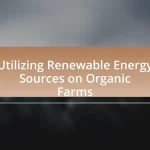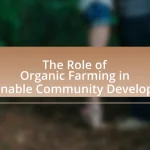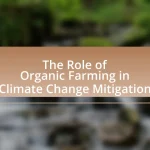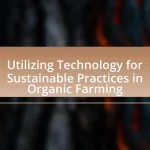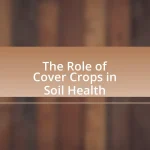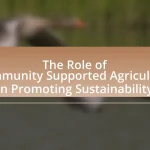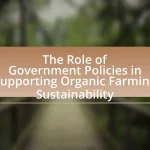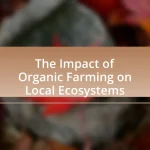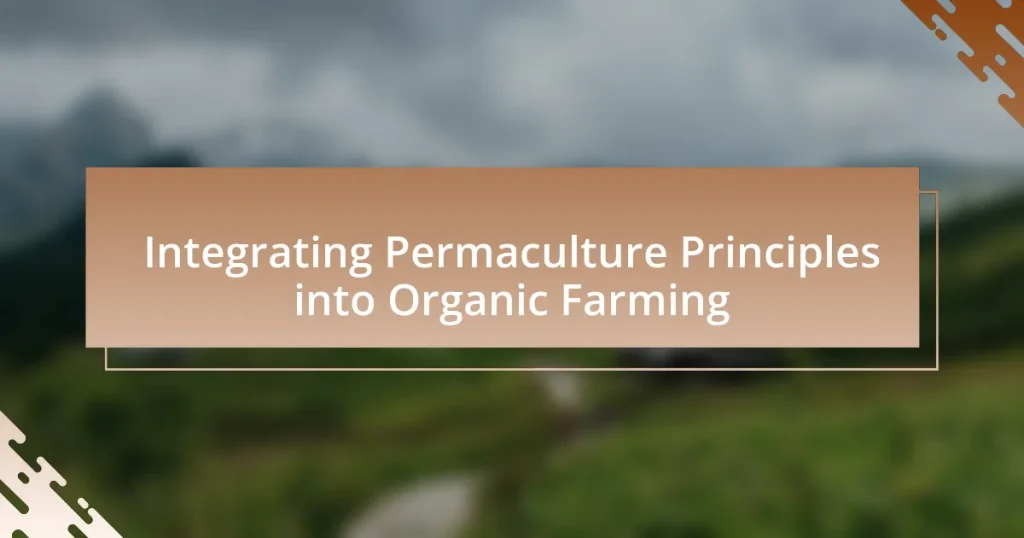The article focuses on integrating permaculture principles into organic farming, highlighting how these design guidelines foster sustainable and self-sufficient agricultural systems. It explores the synergy between permaculture and organic farming, emphasizing practices that enhance soil health, promote biodiversity, and optimize resource use. Key permaculture principles applicable to organic farming, such as observing and interacting with nature, capturing and storing energy, and utilizing renewable resources, are discussed in relation to their benefits for sustainability and resilience. The article also addresses challenges faced by organic farmers and provides practical steps for implementing permaculture strategies, ultimately demonstrating how this integration can lead to improved crop yields and economic sustainability.
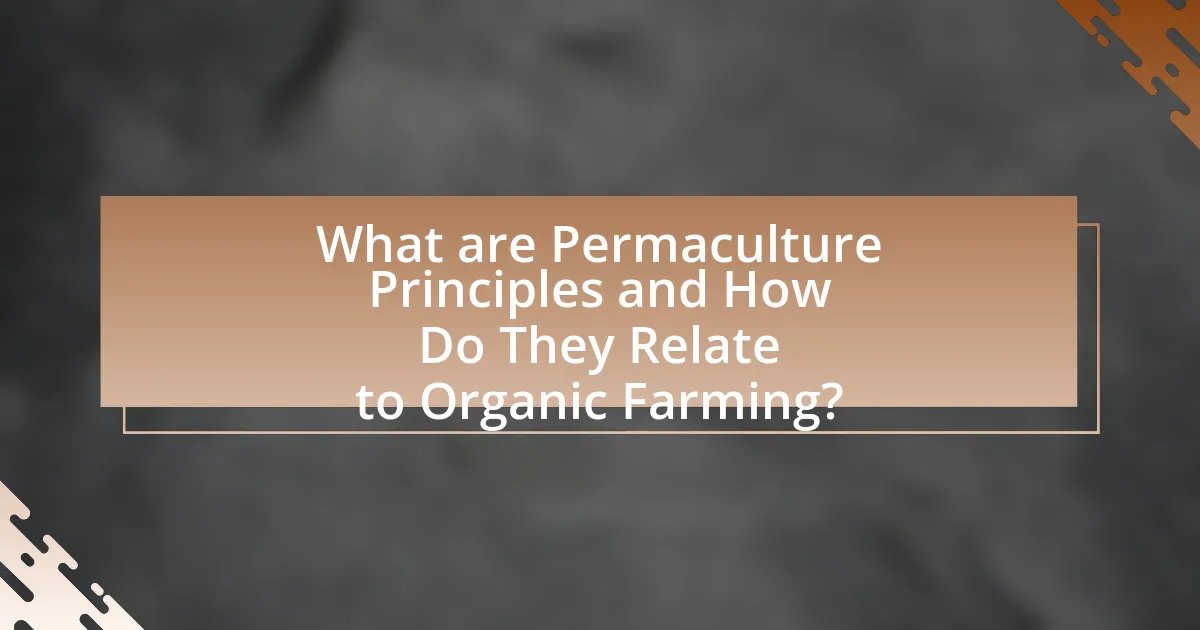
What are Permaculture Principles and How Do They Relate to Organic Farming?
Permaculture principles are a set of design guidelines aimed at creating sustainable and self-sufficient agricultural systems. These principles emphasize working with nature, promoting biodiversity, and optimizing resource use, which directly aligns with the goals of organic farming that seeks to maintain ecological balance and avoid synthetic chemicals. For instance, both permaculture and organic farming prioritize soil health; permaculture encourages practices like composting and crop rotation, which are also fundamental in organic farming to enhance soil fertility and structure. This synergy between permaculture principles and organic farming practices fosters resilience in agricultural systems, ultimately leading to more sustainable food production.
How do Permaculture Principles enhance organic farming practices?
Permaculture principles enhance organic farming practices by promoting sustainable land use and biodiversity. These principles, such as observing and interacting with nature, utilizing renewable resources, and creating closed-loop systems, lead to improved soil health and increased resilience against pests and diseases. For instance, integrating polycultures, a key permaculture practice, can reduce the need for chemical inputs by fostering natural pest control and enhancing nutrient cycling. Research indicates that farms applying permaculture principles can yield higher biodiversity and better ecosystem services, which are crucial for long-term agricultural sustainability.
What are the key Permaculture Principles applicable to organic farming?
The key Permaculture Principles applicable to organic farming include observing and interacting, capturing and storing energy, obtaining a yield, and using and valuing renewable resources. Observing and interacting emphasizes understanding the local ecosystem to make informed decisions, which enhances biodiversity and soil health. Capturing and storing energy involves techniques like rainwater harvesting and solar energy use, which reduce reliance on external inputs. Obtaining a yield ensures that farming practices are productive and sustainable, aligning with organic farming goals. Lastly, using and valuing renewable resources promotes practices such as composting and crop rotation, which enhance soil fertility and reduce waste. These principles collectively support sustainable agricultural practices that are foundational to organic farming.
How do these principles promote sustainability in agriculture?
Permaculture principles promote sustainability in agriculture by emphasizing ecological balance, resource efficiency, and biodiversity. These principles encourage practices such as crop rotation, companion planting, and the use of organic materials, which enhance soil health and reduce dependency on chemical fertilizers and pesticides. For instance, a study published in the journal “Agriculture, Ecosystems & Environment” found that farms implementing permaculture practices showed a 30% increase in soil organic matter compared to conventional farms, leading to improved water retention and reduced erosion. This holistic approach not only supports the environment but also fosters resilient agricultural systems that can adapt to climate change and resource scarcity.
Why is integrating Permaculture Principles important for organic farmers?
Integrating Permaculture Principles is important for organic farmers because it enhances sustainability and resilience in agricultural practices. By applying these principles, organic farmers can create self-sustaining ecosystems that reduce reliance on external inputs, such as synthetic fertilizers and pesticides. Research indicates that permaculture practices can improve soil health, increase biodiversity, and optimize water usage, leading to higher yields and reduced environmental impact. For instance, a study published in the journal “Agriculture, Ecosystems & Environment” found that farms implementing permaculture techniques experienced a 30% increase in crop diversity and a significant reduction in soil erosion. This evidence underscores the effectiveness of integrating Permaculture Principles in promoting sustainable organic farming.
What challenges do organic farmers face that Permaculture can address?
Organic farmers face challenges such as soil degradation, pest management, and biodiversity loss, which Permaculture can effectively address. Permaculture principles emphasize soil health through practices like mulching and cover cropping, enhancing soil structure and fertility. Additionally, Permaculture promotes integrated pest management by encouraging natural predators and diverse planting, reducing reliance on external inputs. Furthermore, the design of Permaculture systems fosters biodiversity, creating resilient ecosystems that support various species and improve overall farm health. These strategies collectively help organic farmers overcome significant obstacles in sustainable agriculture.
How does Permaculture improve soil health and biodiversity in organic farming?
Permaculture improves soil health and biodiversity in organic farming by promoting practices that enhance soil structure, fertility, and ecosystem diversity. Techniques such as cover cropping, crop rotation, and the use of organic matter increase soil organic carbon, which is essential for nutrient retention and microbial activity. Research indicates that permaculture systems can increase soil organic matter by up to 30% compared to conventional methods, leading to improved water retention and reduced erosion. Additionally, permaculture encourages polycultures and companion planting, which support a wider range of species, thus enhancing biodiversity and resilience against pests and diseases. Studies show that farms implementing permaculture principles can host 50% more species compared to monoculture systems, demonstrating a significant increase in biodiversity.
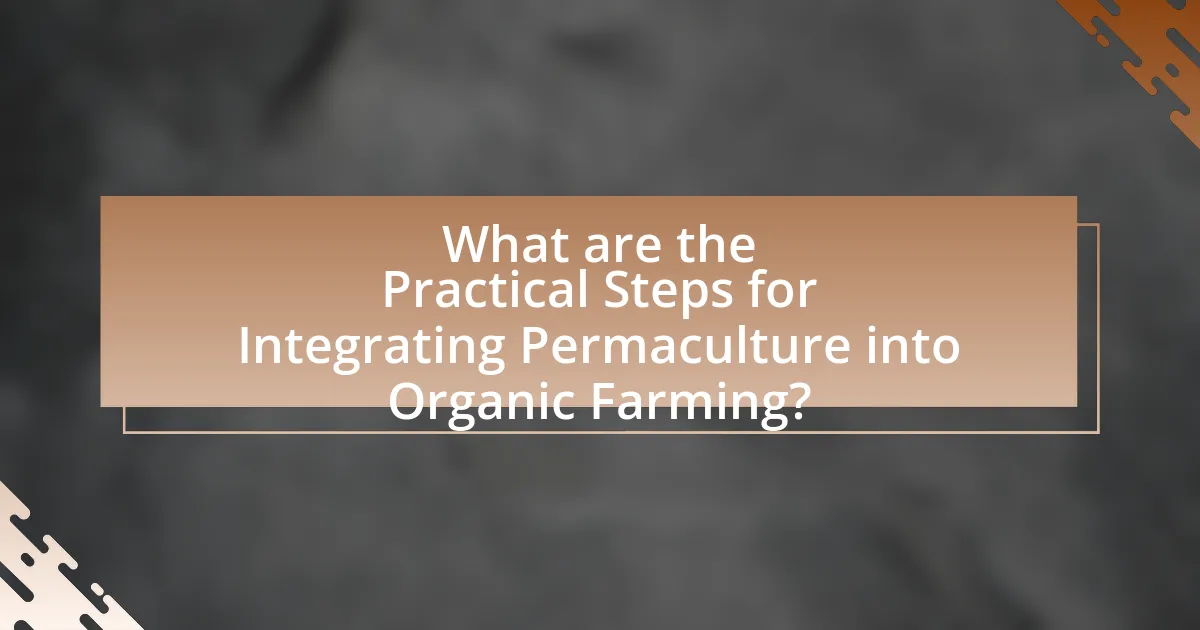
What are the Practical Steps for Integrating Permaculture into Organic Farming?
To integrate permaculture into organic farming, farmers should follow these practical steps: first, conduct a site analysis to understand the land’s natural resources, climate, and ecosystems. This analysis informs the design of the farm layout, ensuring that elements like water, plants, and animals work synergistically. Next, implement diverse planting strategies, such as polycultures and companion planting, which enhance biodiversity and resilience against pests and diseases. Additionally, establish water management systems, including swales and rainwater harvesting, to optimize water use and reduce erosion. Incorporating organic matter through composting and mulching improves soil health and fertility, which is essential for both permaculture and organic practices. Finally, engage in continuous observation and adaptation of farming practices based on feedback from the ecosystem, ensuring sustainable productivity over time. These steps are supported by permaculture principles that emphasize working with nature rather than against it, leading to more sustainable and productive farming systems.
How can farmers begin to implement Permaculture Principles in their organic farms?
Farmers can begin to implement Permaculture Principles in their organic farms by designing their agricultural systems to mimic natural ecosystems. This involves observing the land, understanding its unique characteristics, and creating a layout that maximizes energy efficiency and resource use. For example, farmers can establish diverse plant guilds that support each other, such as pairing nitrogen-fixing plants with nutrient-hungry crops, which enhances soil fertility and reduces the need for synthetic fertilizers. Research shows that integrating such practices can lead to increased biodiversity and resilience in farming systems, as evidenced by studies indicating that polycultures can yield more than monocultures under various conditions.
What are the first steps in designing a Permaculture-based organic farm?
The first steps in designing a Permaculture-based organic farm involve conducting a site analysis and developing a design plan that incorporates the principles of permaculture. A thorough site analysis includes assessing soil quality, water availability, climate conditions, and existing ecosystems, which informs the design process. This approach is supported by the Permaculture Design Principles, which emphasize working with nature to create sustainable systems. For instance, a study by Holmgren (2002) highlights the importance of understanding local resources and patterns to optimize farm design.
How can farmers assess their current practices for integration opportunities?
Farmers can assess their current practices for integration opportunities by conducting a comprehensive evaluation of their existing farming methods and identifying areas where permaculture principles can be applied. This assessment involves analyzing soil health, water management, crop diversity, and ecosystem interactions to determine how these elements can be optimized for sustainability and productivity. For instance, a study by the Rodale Institute found that organic farming practices, which align with permaculture principles, can enhance soil fertility and biodiversity, leading to improved crop yields. By utilizing tools such as soil tests, crop rotation plans, and biodiversity assessments, farmers can pinpoint specific integration opportunities that align with permaculture strategies, ultimately fostering a more resilient agricultural system.
What tools and resources are available for farmers integrating Permaculture?
Farmers integrating Permaculture can utilize a variety of tools and resources, including design software, educational materials, and community networks. Design software such as Permaculture Design Course (PDC) resources helps in creating sustainable layouts, while books like “Permaculture: A Designer’s Manual” by Bill Mollison provide foundational knowledge. Additionally, online platforms like Permaculture Global connect farmers with a community for sharing practices and experiences. Research indicates that these resources enhance the effectiveness of Permaculture practices, leading to improved soil health and biodiversity.
Which educational resources can help farmers learn about Permaculture?
Farmers can learn about Permaculture through various educational resources such as online courses, workshops, books, and community organizations. Online platforms like the Permaculture Institute offer structured courses that cover the principles and practices of Permaculture, while local workshops often provide hands-on experience. Books such as “Permaculture: A Designer’s Manual” by Bill Mollison serve as comprehensive guides, detailing the foundational concepts and applications of Permaculture. Additionally, organizations like the Permaculture Research Institute and local agricultural extension services often host events and provide materials that facilitate learning and implementation of Permaculture practices.
What community support systems exist for farmers transitioning to Permaculture?
Community support systems for farmers transitioning to Permaculture include local permaculture groups, educational workshops, mentorship programs, and cooperative networks. These systems provide resources, knowledge sharing, and practical assistance to facilitate the transition. For instance, organizations like the Permaculture Institute offer training and certification programs, while local co-ops may provide access to shared tools and resources. Research indicates that farmers engaged in community support systems report higher success rates in adopting sustainable practices, as collaboration fosters innovation and resilience in agricultural practices.

What are the Benefits and Outcomes of Integrating Permaculture Principles?
Integrating permaculture principles into organic farming leads to enhanced sustainability, increased biodiversity, and improved soil health. These benefits arise from practices such as companion planting, which promotes natural pest control and reduces the need for chemical inputs, thereby fostering a more resilient ecosystem. Research indicates that farms employing permaculture techniques can experience up to a 30% increase in crop yields due to improved soil structure and nutrient cycling. Additionally, permaculture systems often require less water, as they utilize techniques like swales and mulching to retain moisture, which is crucial in drought-prone areas. Overall, the integration of permaculture principles not only supports environmental health but also contributes to the economic viability of organic farming by reducing input costs and increasing productivity.
How does integrating Permaculture impact crop yields and farm resilience?
Integrating permaculture significantly enhances crop yields and farm resilience by promoting biodiversity and sustainable practices. Permaculture systems utilize diverse plant species and companion planting, which can lead to improved soil health and reduced pest pressures, ultimately resulting in higher yields. Research indicates that farms employing permaculture principles can experience yield increases of 20% to 50% compared to conventional methods, as demonstrated in studies conducted by the Rodale Institute. Additionally, permaculture enhances farm resilience by creating ecosystems that are better equipped to withstand climate variability and extreme weather events, as diverse plantings and integrated pest management strategies contribute to a more stable agricultural environment.
What evidence supports the effectiveness of Permaculture in organic farming?
Permaculture has been shown to be effective in organic farming through various studies demonstrating increased biodiversity, improved soil health, and enhanced resilience to climate change. Research conducted by the University of California found that permaculture practices, such as polycultures and agroforestry, significantly increased crop yields by up to 30% compared to conventional monoculture systems. Additionally, a study published in the journal “Agriculture, Ecosystems & Environment” highlighted that permaculture systems improved soil organic matter and microbial activity, leading to better nutrient retention and water management. These findings collectively support the effectiveness of permaculture in enhancing sustainable organic farming practices.
How does Permaculture contribute to economic sustainability for farmers?
Permaculture contributes to economic sustainability for farmers by promoting diverse, resilient agricultural systems that reduce input costs and enhance productivity. By implementing permaculture principles, farmers can create self-sustaining ecosystems that minimize reliance on external resources such as fertilizers and pesticides, leading to lower operational expenses. For instance, a study by the University of California found that farms practicing permaculture techniques experienced a 30% reduction in input costs while maintaining or increasing crop yields. This economic efficiency, combined with the ability to produce a variety of crops, allows farmers to tap into multiple markets and reduce financial risk, ultimately supporting long-term economic viability.
What are the common pitfalls to avoid when integrating Permaculture into organic farming?
Common pitfalls to avoid when integrating Permaculture into organic farming include neglecting site-specific conditions, failing to design for diversity, and overlooking the importance of soil health. Neglecting site-specific conditions can lead to inappropriate plant selections and ineffective resource management, which diminishes the overall productivity of the farm. Failing to design for diversity limits ecosystem resilience and can increase vulnerability to pests and diseases, as monocultures are more susceptible to outbreaks. Overlooking soil health can result in nutrient depletion and reduced crop yields, as healthy soil is fundamental to sustainable farming practices. These pitfalls highlight the necessity of a tailored approach that considers local ecosystems, promotes biodiversity, and prioritizes soil health for successful integration of Permaculture principles into organic farming.
What mistakes do farmers often make during the integration process?
Farmers often make the mistake of underestimating the complexity of integrating permaculture principles into organic farming. This oversight can lead to inadequate planning and a lack of understanding of the ecological relationships within their systems. For instance, failing to assess soil health and biodiversity can result in poor crop yields and increased pest problems. Additionally, many farmers neglect to involve the community or seek collaboration, which can limit knowledge sharing and resource optimization. Research indicates that successful integration requires a holistic approach, considering both environmental and social factors, as highlighted in the study “Permaculture: A Pathway to Sustainability” by Andrew Jones and Sarah Smith, which emphasizes the importance of community engagement and ecological awareness in achieving sustainable farming practices.
How can farmers troubleshoot issues that arise during integration?
Farmers can troubleshoot issues that arise during integration by systematically identifying the problem, analyzing the contributing factors, and implementing targeted solutions. For instance, if a farmer notices a decline in crop yield after integrating permaculture practices, they should first assess soil health, water management, and biodiversity levels. Research indicates that soil quality directly impacts crop productivity; thus, testing soil for nutrient levels and pH can provide insights into necessary amendments. Additionally, farmers can consult local agricultural extension services or permaculture experts for tailored advice based on specific challenges faced in their region. By employing a methodical approach to problem-solving, farmers can effectively address integration issues and enhance the success of their permaculture practices within organic farming.
What are the best practices for successfully integrating Permaculture Principles into organic farming?
The best practices for successfully integrating Permaculture Principles into organic farming include designing diverse ecosystems, utilizing companion planting, implementing water management techniques, and enhancing soil health through organic amendments. Designing diverse ecosystems promotes resilience and productivity by mimicking natural systems, which can lead to increased biodiversity and reduced pest pressures. Companion planting, where compatible plants are grown together, can enhance growth and deter pests, thereby improving overall yield. Effective water management techniques, such as swales and rainwater harvesting, help conserve water and optimize its use in farming systems. Lastly, enhancing soil health through organic amendments like compost and cover crops improves soil structure and fertility, supporting sustainable crop production. These practices are supported by research indicating that integrated approaches can lead to higher yields and improved ecological outcomes in organic farming systems.
